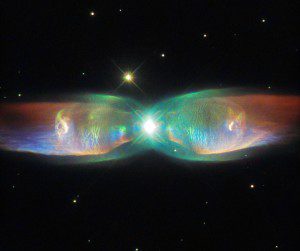
This new image of the Twin Jet Nebula was captured using the NASA/ESA Hubble Space Telescope and its Space Telescope Imaging Spectrograph.
A new image from the NASA/ESA Hubble Space Telescope captures the Twin Jet Nebula's shells and knots of expanding gas, as two iridescent lobes of material stretch outwards from a central star system. Within these lobes, two huge jets of gas are streaming from the star system at speeds in excess of 1 million kilometers (621,400 miles) per hour.
Astronomers have found that the two stars in this pair each have approximately the same mass as the sun. The larger star is approaching the end of its days and has already ejected its outer layers of gas into space, whereas its partner is further evolved and is a small white dwarf.
It's believed that as the dying star and white dwarf orbit around their common center of mass, the ejected gas from the dying star is pulled into two lobes rather than expanding as a uniform sphere. Meanwhile, the nebula's wings are still growing and, by measuring their expansion, astronomers have calculated that the nebula was created only 1,200 years ago.
The two stars at the heart of the nebula circle one another roughly every 100 years. This rotation creates the wings of the butterfly and the two jets, allowing the white dwarf to strip gas from its larger companion, which then forms a large disc of material around the stars, extending out as far as 15 times the orbit of Pluto. Although this disk is of incredible size, it's much too small to be seen on the image taken by Hubble.

